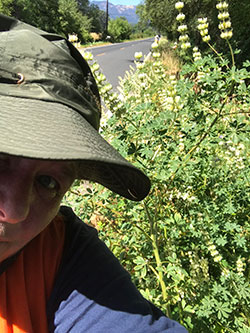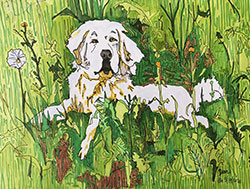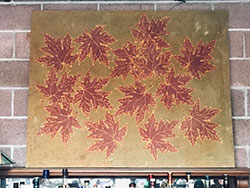CDFW Senior Environmental Scientist Jenn Garrison at the American Museum of Natural History in New York City

Jenn Garrison stands next to Milo-Baker Lupine, a rare native plant found only in Mendocino County.

A one-time art major in college, Jenn Garrison occasionally draws pet portraits for friends and fundraisers.

Away from work, Jenn Garrison’s various art interests – ceramics, painting, wall hangings, photography -- keep her busy.
Jennifer Garrison is a senior environmental scientist (specialist) based in Fort Bragg, Mendocino County. She joined CDFW’s Habitat Conservation Planning Branch in Sacramento in 2013 after working more than a decade as a project manager and environmental consultant in the private sector. Jenn moved to Fort Bragg in 2017 to bring her expertise and experience in conservation planning, habitat connectivity, mitigation and regional planning to Mendocino County.
Jenn was born outside of Athens, Ga., and grew up there and in South Carolina. She spent a good portion of her childhood on Folly Beach, S.C., an island town off of Charleston. She holds a bachelor’s degree in physical anthropology from Kent State University in Ohio.
You’re a long way from your childhood roots in the South. To what degree does your upbringing in the South reflect who you are and what you do today?
My parents were rather hands-off and as such raised children who became very independent. I spent much of my childhood exploring the natural world, romping around forests and estuaries with my Labrador retriever. I think my upbringing instilled a sense of curiosity, compassion and a duty to serve and contribute to my community.
Let’s say you’re at a party without any scientists or CDFW employees around. How do you explain what you do for a living?
I am CDFW’s conservation planner in Mendocino County. I am here to work with others to pursue conservation, restoration and regional planning opportunities to save the best of what’s left, restore and reconnect habitats and increase the landscape’s permeability for wildlife movement.
What are some of the big challenges facing Mendocino County from your perspective?
Our county is in a period of transition, shifting from traditional industries – timber and fishing – to increased agricultural and tourism-based economies – cannabis, vineyards and eco-tourism. Collaboration and partnerships are and will continue to be essential for Mendocino County’s sustainable future. I am looking to strengthen those relationships and develop new ones through collaborative projects with local government, other agencies, special districts, public and private landowners, developers, universities, nonprofits and the public through engagement and citizen science programs. It’s through this work that I hope we will craft a future that highlights Mendocino County’s biodiversity and champions the sustainability of our industries into the future.
What does a typical day at work look like for you?
Prior to March, I was split between field work, meetings and desk time with an occasional bear tag validation. My portfolio includes a fair bit of work with rare plants and sensitive natural communities, something I wouldn’t have dreamed I’d be ever doing – and it wouldn’t have been possible without the tutelage of my supervisor, Gordon Leppig, our VegCAMP (Vegetation Classification and Mapping Program) staff, and local experts. Hands-on field work, community outreach, and collaborating with CDFW staff in other programs, non-governmental organizations, and private and public landowners are key components of my job. My greatest passion is habitat connectivity, and I’ve become a resource for CDFW scientists around the state for their connectivity questions. Since COVID-19 shelter in place began, my days are far more predictable. Less field time has translated into immense focus on existing and new projects, including a few regional planning efforts. My work involves lots of variability. It’s always interesting and there’s never enough hours in the days.
What are some of the bigger projects you’re working on?
When I moved to Fort Bragg, I became the department’s lead on the Willits Bypass project. In 2013-14, Caltrans built a freeway bypass to route Highway 101 traffic around the community of Willits, which resulted in Caltrans purchasing roughly 2,000 acres of land to the east of Highway 101 as mitigation for impacts to state and federal resources. The Mendocino County Resource Conservation District (RCD) manages the property and CDFW will hold the conservation easement, so we’re partners out there.
It was grazing land for 100 years, but we think about what it might look like in the next 100 years – not just the next 10 years. We’re now looking at how grazing can be used to control invasive plant species and encourage the growth of native plant species. The RCD modified fences to allow wildlife movement across the mitigation lands, which increases habitat connectivity. We’re seeing an uptick in species diversity and abundance. About five years ago, elk came onto the mitigation lands for the first time in decades. Now they are there year-round. We have beavers that have moved in for the first time in 70 years and we have an expanding river otter population as well. They’re doing a lot of free restoration work for us. We hadn’t seen amphibians in those creeks for years but last year we found a larval Pacific giant salamander in one of the creeks. This means at least one species of salamander has begun to breed in the mitigation lands’ creeks. We envision a field research station of sorts out there some day. The RCD has begun public tours and there are endless possibilities for outdoor education and research.
I’ve also been working to protect and preserve the Mendocino Cypress Pygmy Forest, one of the rarest plant ecosystems in the world and working with Caltrans and CDFW’s Native Plant Program staff at headquarters to maintain – and I hope someday recover – the Milo Baker lupine, a native plant that only exists in Mendocino County’s Round Valley.
What advice would you give someone considering a career in natural resources?
Consider reading David Quammen’s The Song of the Dodo and E.O. Wilson’s Consilience. They’re inspiring. Know that there will be challenging days that test your resolve but keep going. Find mentors and nurture relationships with colleagues. Learn as much as you can from others, apply that knowledge, and build on it. Share your knowledge and think big; consider how your work fits into the broader landscape and how it contributes to sustaining – if not recovering – species diversity and abundance. Make it your goal to keep common species common. Don’t just focus on the listed species. Connect the dots and challenge yourself to see opportunities in every problem.
Tell us something about yourself many people would be surprised to learn.
I entered college as an art major with an emphasis on ceramics and have had many art shows over the years displaying my art, including batik wall hangings and photographs.
CDFW Photos